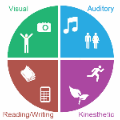
Integrating and processing information from various sources or modalities are critical for obtaining a comprehensive and accurate perception of the real world. Drawing inspiration from neuroscience, we develop the Information-Theoretic Hierarchical Perception (ITHP) model, which utilizes the concept of information bottleneck. Distinct from most traditional fusion models that aim to incorporate all modalities as input, our model designates the prime modality as input, while the remaining modalities act as detectors in the information pathway. Our proposed perception model focuses on constructing an effective and compact information flow by achieving a balance between the minimization of mutual information between the latent state and the input modal state, and the maximization of mutual information between the latent states and the remaining modal states. This approach leads to compact latent state representations that retain relevant information while minimizing redundancy, thereby substantially enhancing the performance of downstream tasks. Experimental evaluations on both the MUStARD and CMU-MOSI datasets demonstrate that our model consistently distills crucial information in multimodal learning scenarios, outperforming state-of-the-art benchmarks.
翻译:暂无翻译



